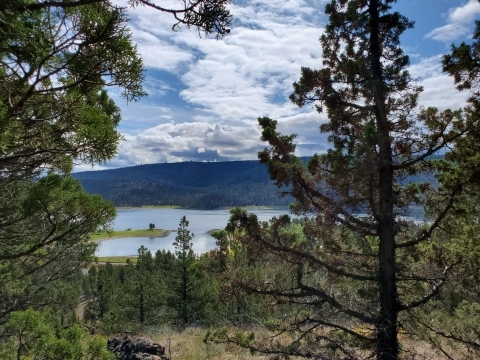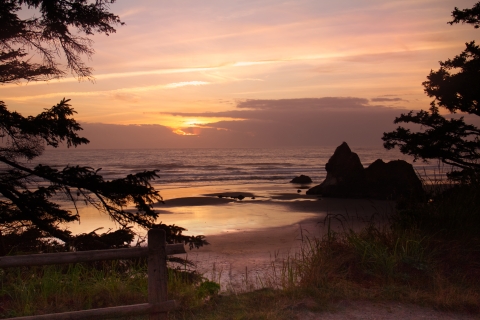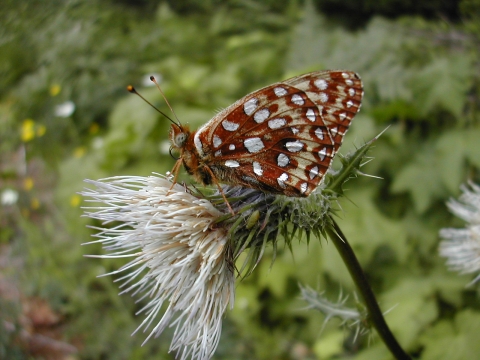Locations
The U.S. Fish and Wildlife Service has staff located throughout the state of Oregon to work with you, right where you live, to conserve wildlife and their habitats for future generations. We have field offices in Portland, Roseburg, Bend, and La Grande.
Drop Us a Line
If you live or work in Oregon and have questions, concerns, or projects pertaining to federally listed wildlife and their habitats, feel free to get in touch. Our staff is ready to help.
State Supervisor
Kessina Lee - (503) 231-6179
The Bend Field Office covers nine counties in central Oregon including Deschutes, Crook, Jefferson, Wheeler, Wasco, Sherman, Gilliam, Harney, and Lake Counties, and portions of Klamath and Malheur counties.
Conservation is a dish best served locally, which is why the U.S. Fish & Wildlife Service has staff located throughout the state of Oregon to work with you, right where you live, to conserve wildlife and their habitats for future generations.
Sustainable water management for people and wildlife is a balancing act that has taken years to achieve in the Deschutes River Basin. Learn how we are working with partners to accomplish this goal: Deschutes Habitat Conservation Plan.
Working Locally With You
So what is it we actually do in Central Oregon? While the projects are many, we can break things down into larger categories:
- Restoring and maintaining healthy ecosystems
- Recovering threatened and endangered species
- Conserving species before they are in danger of extinction
- Partnerships
How We Can Help
We work with citizens, businesses, local governments, and environmental organizations on a number conservation activities, including:
- Endangered Species Act Consultation
- Environmental Education
- Fish Passage
- Habitat Conservation Plans
- Fire Learning
- Energy Projects
Species in Central Oregon
From the iconic, to the sensitive, to the just plain interesting, we've highlighted some of the species we work with in Central Oregon — pygmy rabbit, greater sage-grouse, Oregon spotted frog, bull trout, and Borax Lake chub.
Drop Us a Line
If you live or work in this area and have questions, concerns, or projects pertaining to federally listed wildlife and their habitats, feel free to get in touch. Our staff is ready to help.
Field Supervisor
Emelie McKain - 541-383-7146
The La Grande Field Office covers seven counties in eastern Oregon: Malheur, Baker, Grant, Union, Wallowa, Umatilla, and Morrow.
Conservation is a dish best served locally, which is why the U.S. Fish & Wildlife Service has staff located throughout the state of Oregon to work with you, right where you live, to conserve wildlife and their habitats for future generations.
Working Locally With You
So what is it we actually do in eastern Oregon? While the projects are many, we can break things down into some larger categories:
- Restoring and Maintaining Healthy Ecosystems
- Species Recovery: for those already in danger
- Species Conservation: to hopefully avoid becoming in danger
- Partnerships
How We Can Help
The USFWS stays very busy in eastern Oregon, working with citizens, businesses, local governments, and environmental organizations on a number conservation activities, including:
- Endangered Species Act Consultation
- Conservation Education
- Species Monitoring
Species of Eastern Oregon
From the iconic, to the sensitive, to the just plain interesting, we've highlighted some of the species with which we work most closely on the eastern Oregon — greater sage-grouse, bull trout, North American wolverine, Columbia spotted frog, and whitebark pine.
Drop Us a Line
If you live or work in this area and have questions, concerns, or projects pertaining to federally listed wildlife and their habitats, feel free to get in touch. Our staff is ready to help.
Acting Field Supervisor
Randy Riggs (503) 231-6179
The Portland Field Office covers three regions – Coastal, Willamette Valley, and the Cascades.
Learn About What We Do
The Service’s Portland Field Office stays very busy, working with citizens, businesses, other federal agencies, local governments, and environmental organizations on a number of conservation activities, including:
- Conservation and Recovery of Threatened and Endangered Species
- Coastal Programs (help with habitat restoration on both private and public lands)
- Fish Passage
- Safe Harbor Agreements for private landowners
- Habitat Conservation Plans (associated with incidental take permits for listed species)
- Natural Resource Damage Assessment and Restoration
- Endangered Species Act Consultation (for federal agency actions)
- Are you with a federal agency needing to consult on an upcoming activity? Your first stop should be HERE.
How You Can Help
What should you do if you find a sea turtle or marine mammal stranded in an unnatural situation?
Call the Marine Mammal Stranding Network at 1-866-767-6114 or Oregon State Police, Wildlife Division at 1-800-452-7888. More info HERE.
What should you do if you find an unmarked western snowy plover nest?
Please keep a respectful distance of 50 feet and report the nest’s location immediately to Oregon Parks and Recreation Department.
What should you do if you see sick or dead birds?
The Oregon Department of Fish and Wildlife (ODFW) cannot test every dead bird but may want to test birds in locations where multiple birds have died and the disease has not yet been detected. You can contact ODFW’s Wildlife Health Lab at 866-968-2600 or odfw.wildlifehealth@odfw.oregon.gov if you see multiple dead birds in the same location. For your safety, please do NOT touch any sick or dead birds you find.
Living with our bald eagle neighbors
Wondering whether you need a permit for an activity that might impact bald eagles? The Service recently took steps to streamline the process for permits related to qualifying wind-energy generation projects, power line infrastructure, activities that may disturb breeding bald eagles, and bald eagle nest take; you can find more information HERE.
Northwest Oregon and Coastal Species
From the iconic, to the sensitive, to the just plain interesting, we've highlighted some of the species we work with in this areas — western snowy plover, marbled murrelet, coastal marten, northern spotted owl, Kincaid's lupine, sand dune phacelia, loggerhead sea turtles, bull trout, Pacific lamprey, and Oregon silverspot butterfly.
Drop Us a Line
If you live or work in this area and have questions, concerns, or projects pertaining to federally listed wildlife and their habitats, feel free to get in touch. Our staff is ready to help. Contact the Portland Field Supervisor to be directed to the appropriate staff person.
Field Supervisor
Michele Zwartjes, (503) 231-6179
The Roseburg Field Office covers Coos, Curry, Douglas, Jackson, and Josephine counties.
Conservation is a dish best served locally, which is why the U.S. Fish & Wildlife Service has staff located throughout the state of Oregon to work with you, right where you live, to conserve wildlife and their habitats for future generations.
Working Locally With You
So what is it we actually do in southwest Oregon? While the projects are many, we can break things down into some general categories:
- Restoring and Maintaining Healthy Ecosystems
- Species Recovery: for those already in danger
- Species Conservation: to keep them from becoming in danger
- Partnerships
Species of Southwest Oregon
From the iconic, to the sensitive, to the just plain interesting, we've highlighted some of the species with which we work most closely in southwest Oregon — northern spotted owl, fisher, Pacific marten, vernal pool fairy shrimp, Franklin's bumble bee, and other pollinators.
How We Can Help
The USFWS stays very busy in southwest Oregon, working with citizens, businesses, local governments, and environmental organizations on a number conservation activities, including:
- Endangered Species Act Consultation
- Habitat Conservation Plans
- Conserving Pollinators
Drop Us a Line
If you live or work in this area and have questions, concerns, or projects pertaining to federally listed wildlife and their habitats, feel free to get in touch. Our staff is ready to help.
Field Supervisor
Mike Asch (541) 957-3470










